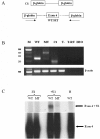Homozygous mutation in SPATA16 is associated with male infertility in human globozoospermia
- PMID: 17847006
- PMCID: PMC2227931
- DOI: 10.1086/521314
Homozygous mutation in SPATA16 is associated with male infertility in human globozoospermia
Abstract
Globozoospermia is a rare (incidence <0.1% in male infertile patients) form of teratozoospermia, mainly characterized by round-headed spermatozoa that lack an acrosome. It originates from a disturbed spermiogenesis, which is expected to be induced by a genetic factor. Several family cases and recessive mouse models with the same phenotype support this expectation. In this study, we present a consanguineous family with three affected brothers, in whom we have identified a homozygous mutation in the spermatogenesis-specific gene SPATA16. This is the first example of a nonsyndromic male infertility condition in humans caused by an autosomal gene defect, and it could also mean that the identification of other partners like SPATA16 could elucidate acrosome formation.
Figures



References
Web Resources
-
- dbSNP, http://www.ncbi.nlm.nih.gov/SNP/ (for exon 10 c.1526C→T [accession number ss73688634], exon 10 c.1577T→C [accession number ss73688636], and exon 4 c.848G→A [accession number ss73688635])
-
- NetGene2 Server, http://www.cbs.dtu.dk/services/NetGene2/
-
- Online Mendelian Inheritance in Man (OMIM), http://www.ncbi.nlm.nih.gov/Omim/ (for globozoospermia, CSNK2A2, HRB, GOPC, SPATA16, acrosin, and TPR)
-
- SDSC Biology Workbench, http://workbench.sdsc.edu/ (for Biology Workbench 3.2 and ClustalW 1.81)
References
-
- World Health Organization (1999) WHO laboratory manual for the examination of human semen and sperm–cervical mucus interaction. 4th ed. Cambridge University Press, Cambridge, United Kingdom
-
- Holstein AF, Schirren CG, Schirren C, Mauss J (1973) [Round headed spermatozoa: a cause of male infertility.] Dtsch Med Wochenschr 98:61–62 - PubMed
-
- Schirren CG, Holstein AF, Schirren C (1971) Uber die Morphogenese rundkopfiger Spermatozoen des Menschen. Andrologie 3:117–125
-
- Dale B, Iaccarino M, Fortunato A, Gragnaniello G, Kyozuka K, Tosti E (1994) A morphological and functional study of fusibility in round-headed spermatozoa in the human. Fertil Steril 61:336–340 - PubMed
Publication types
MeSH terms
Substances
LinkOut - more resources
Full Text Sources
Other Literature Sources
Medical
Molecular Biology Databases

